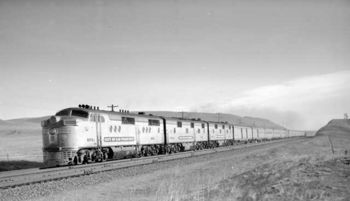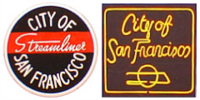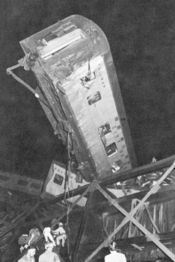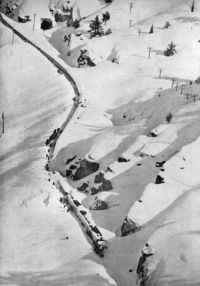City of San Francisco
- For the city, see San Francisco, California.


The City of San Francisco was a streamlined passenger train operated jointly by the Chicago and North Western Railway, the Southern Pacific Railroad, and the Union Pacific Railroad. The service ran between Chicago, Illinois and Oakland, California. This train was marketed as a direct competitor to the San Francisco Chief, a streamlined passenger train operated by the Atchison, Topeka and Santa Fe Railway. As with the City of Los Angeles, many of the train's cars bore the names of locales in and around its namkesake city, including Mission Dolores, the nickname given to San Francisco's Mission San Francisco de Asís.
On August 12, 1939 the train derailed while crossing a bridge near Carlin, Nevada, killing 24 and injuring 121. The wreck appeared to have been caused by sabotage but remains unsolved to this day.
The City of San Francisco is perhaps best remembered for the January, 1952 disaster when a blizzard in the Sierra Nevada Mountains snowbound the train for 6 days at Yuba Pass, California. The incident occurred when snowdrifts from the blizzard's 100 mile-per-hour winds blocked the train, burying it in 12 feet of snow and stranding it from January 13 to January 19. The event made international news headlines. In the effort to reach the train, the railroad's snow-clearing equipment and snow-blowing rotary augers became frozen to the tracks. Subsequently, hundreds of workers and volunteers using manual snowplows, tractors and manpower came to the rescue by clearing the adjacent Lincoln Highway (the first road across America) to reach the train. The 196 passengers and 20 crewmembers were evacuated within 48 hours, on foot through the snow, to vehicles which transported them to emergency facilities at Nyack Lodge on the highway. The train itself was finally dug out several days later.
In 1955 the Milwaukee Road assumed the service, replacing the Chicago and Northwestern between Chicago and Omaha. In a cost-cutting move, the City of San Francisco was combined with the City of Los Angeles in 1960.
Contents
History
Timeline
- 1936: The weekly City of San Francisco makes its first run between Chicago, Illinois and Oakland, California.
- August 12, 1939: An act of sabotage sends the City of San Francisco flying off of a bridge in the Nevada desert; two dozen passengers and crew members are killed and many more injured, and five cars are destroyed.
- January, 1952: The City of San Francisco is caught in a severe blizzard and remains stuck for days.
- May 1, 1971: UP ends the City of San Francisco train as Amtrak takes over long-distance passenger operations in the United States and retains the name for some years.
Other railroad uses of the name City of San Francisco
The City of San Francisco name has also been applied to a 10/6 sleeping car built by Pullman Standard in the early 1950s. The car is currently owned by the Boone & Scenic Valley Railroad and operated as part of the line's dinner and first class trains.
References
- Schafer, Mike and Joe Welsh (1997). Streamliners: History of a Railroad Icon. MBI Publishing Co., St. Paul, MN. ISBN 0-7603-1371-7.
See also
- Passenger train service on the Chicago and North Western Railway
- Passenger train service on the Southern Pacific Railroad
- Passenger train service on the Union Pacific Railroad
External links
- "The Case of the Stranded Streamliner" offers detailed information and photographs of the 1952 disaster.
- "Recalling a Train Wreck" offers information and photographs of the 1939 derailment.
- Passenger trains operating on the eve of Amtrak


